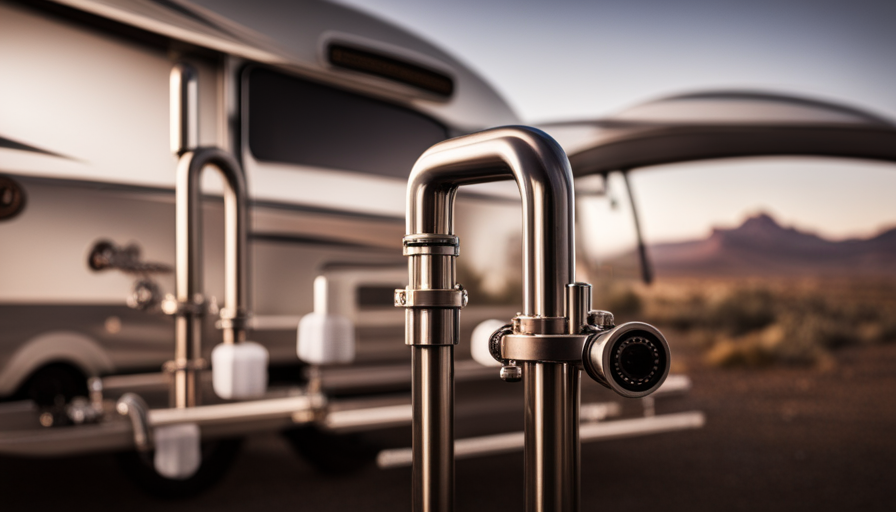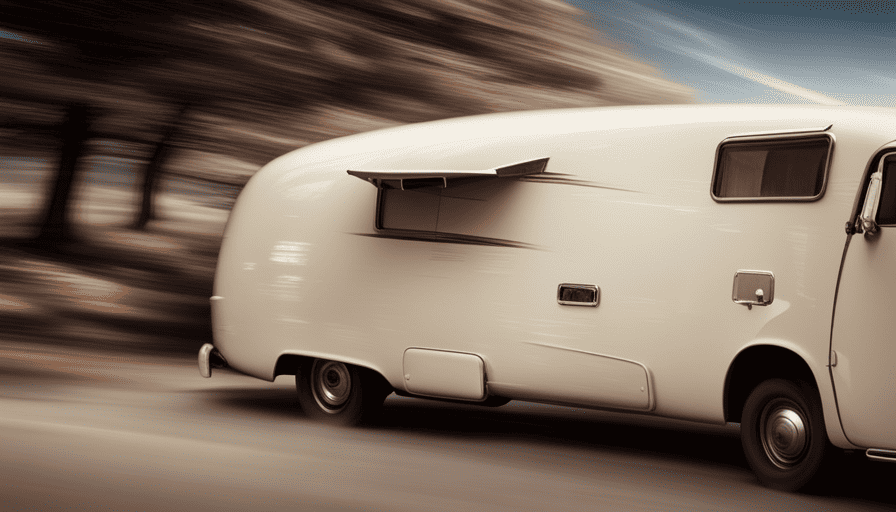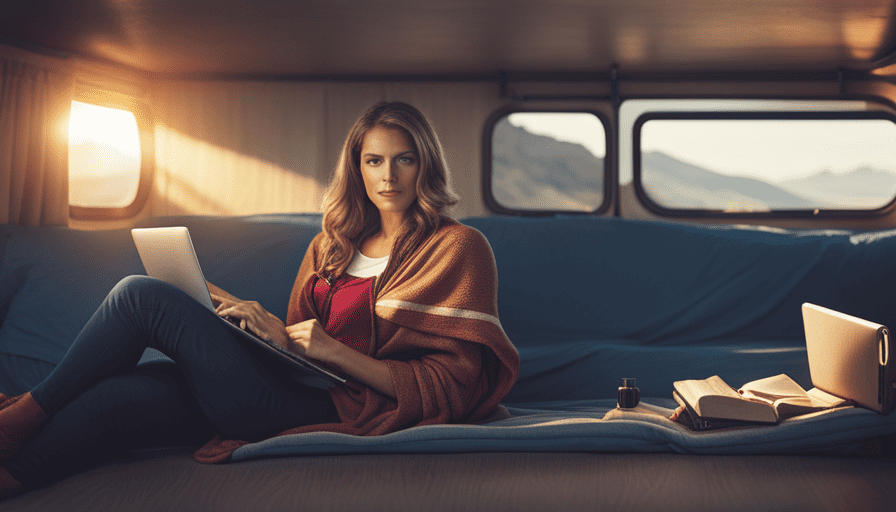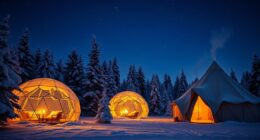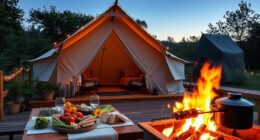Loading up a camping trailer might appear intimidating, but don’t worry! I’ve got your back and will help navigate you through the process to Ensure it’s as seamless as can be.
Picture this: you’re about to embark on a grand adventure, exploring the great outdoors in the comfort of your own camper. But before you hit the road, you need to master the art of packing. Trust me, it’s not as overwhelming as it sounds.
With a little planning and organization, you’ll have your camper packed like a pro in no time. In this article, I’ll share my top tips and tricks for efficiently packing your camper. From assessing your storage space to securing loose items, I’ve got you covered.
So grab a pen and paper, because we’re about to create a packing plan that will make your camper feel like a cozy home away from home.
Let’s get started!
Key Takeaways
- Plan and organize your packing process
- Utilize space-saving storage solutions and containers for organization
- Pack heavy items first and distribute weight evenly for proper weight distribution
- Consider accessibility when packing and keep pathways clear inside the camper
Assess Your Storage Space
You’ll need to take a close look at your storage space and determine how much room you have to work with. Maximizing space is key when packing a camper, so it’s important to make the most of every nook and cranny.
Start by removing any unnecessary items from your camper to create more space. Once you have a clear understanding of the storage space available, it’s time to consider using containers to organize and pack your belongings.
Using containers can help keep your items secure and make them easier to access when needed. Opt for storage bins that are stackable and fit well in the available spaces. Utilize the space under beds and seats by using low-profile containers. Hanging shoe organizers can also be great for storing small items like toiletries or kitchen utensils.
Additionally, consider using vacuum-sealed bags for clothing and bedding to save even more space. These bags compress the items, allowing you to pack more efficiently. Remember to label your containers to easily locate items later on.
Now that you know how to maximize space and use containers, it’s time to make a packing list for your camper adventure.
Make a Packing List
Don’t forget to jot down all the must-haves for your epic camping adventure! Making a packing list is essential to ensure you have everything you need for a successful trip.
Start by considering the essential camping gear you’ll need. This includes a tent, sleeping bags, camping chairs, lanterns, and cooking equipment. Make sure to check that everything’s in good condition and functioning properly.
Next, think about meal planning and food storage. Plan your meals in advance, considering the number of days you’ll be camping and the number of people in your group. Pack non-perishable items like canned food, granola bars, and dried fruits. For perishable items, invest in a cooler and pack them with ice packs to keep them fresh. Don’t forget to bring cooking utensils, plates, and cutlery.
To transition into the next section, organize your items into categories to make packing and unpacking easier. Separate your camping gear, food, and personal items into different sections. This’ll help you stay organized and ensure that you can easily find what you need when you arrive at your campsite.
Organize Your Items into Categories
Get ready to feel a sense of calm and control as you effortlessly sort your belongings into neat and organized categories for your camping adventure. Organizing your items into categories not only helps maximize storage space but also makes it easier to find what you need when you arrive at your destination.
Here are three categories to consider:
-
Clothing: Separate your clothes into categories such as tops, bottoms, and outerwear. Roll them up tightly to save space and place them in vacuum-sealed bags. This not only compresses the clothing but also protects them from moisture.
-
Kitchen Supplies: Gather all your cooking utensils, pots, pans, and plates. Group similar items together and pack them in stackable containers. Utilize compartments in your camper’s kitchen area to store these items securely.
-
Outdoor Gear: Categorize your camping essentials like tents, sleeping bags, and camping chairs. Use duffle bags or storage bins to keep these items together and easily accessible.
By organizing your items into categories, you’ll be able to maximize storage space and utilize compartments effectively. This will ensure that everything has its designated place, making it easier to find and use.
Next, we’ll explore how to use space-saving storage solutions to pack your camper even more efficiently.
Use Space-Saving Storage Solutions
Make your camping adventure even more enjoyable by utilizing space-saving storage solutions that will help you maximize every inch of your storage area. When you’re packing a camper, it’s crucial to maximize efficiency and make the most of the limited space you have.
One of the best ways to do this is by utilizing compact containers. These containers come in various sizes and shapes, allowing you to fit them into the smallest of spaces. From collapsible storage bins to vacuum-sealed bags, there are plenty of options to choose from.
To maximize efficiency, consider using stackable containers that can be easily stacked on top of each other. This will not only save space but also keep your items organized and easily accessible. Additionally, consider investing in storage solutions such as hanging organizers or storage nets that can be attached to the walls or ceiling of your camper. These can be used to store items like shoes, toiletries, or even kitchen utensils.
By utilizing these space-saving storage solutions, you’ll be able to pack more efficiently and make the most of the limited space in your camper. This will ensure that you have everything you need for your camping adventure without feeling cramped or overwhelmed.
Now, let’s move on to the next step: packing heavy items first.
Pack Heavy Items First
Start your camping adventure off on the right foot by prioritizing heavy items when packing. Not only will this help with weight distribution and stability while on the road, but it’ll also make it easier to access and unpack your camper once you arrive at your destination.
When packing, it’s important to pack heavy items first. This includes things like coolers, pots and pans, and any other bulky equipment you may have. By packing these items at the bottom of your camper, you create a solid foundation for the rest of your belongings.
To pack fragile items and protect breakables, follow these tips:
- Wrap breakables in bubble wrap or packing paper to prevent them from getting damaged during transit.nn2. Place fragile items in sturdy boxes or containers to provide an extra layer of protection.nn3. Use towels or blankets to cushion delicate items and fill any empty spaces to prevent movement.nn4. Label boxes containing fragile items to ensure they’re handled with care.
By packing heavy items first and taking extra precautions to protect breakables, you can ensure a smooth and stress-free camping experience.
Now, let’s move on to the next section and talk about how to utilize vertical space in your camper.
Utilize Vertical Space
Maximize the available space in your camping setup by utilizing the vertical area to store and organize your belongings.
When packing a camper, it’s important to make the most of every inch of storage space. One of the best ways to do this is by thinking vertically. Instead of simply stacking items on top of each other, consider using bins, shelves, and hooks to maximize storage.
Hang lightweight items, such as jackets or hats, on hooks inside the camper or on the exterior walls. This not only frees up floor space but also keeps things easily accessible.
Utilize the ceiling space by installing cargo nets or storage hammocks to hold items like sleeping bags or pillows.
Another creative solution is to use tension rods to create additional shelving. These can be placed between walls or cabinets to hold items like toiletries or kitchen supplies.
By thinking creatively and utilizing vertical space, you can maximize the storage capacity of your camper and keep your belongings organized.
Once you’ve utilized the vertical space, it’s time to secure loose items to ensure a safe and comfortable journey.
Secure Loose Items
To prevent any potential accidents or damage, it’s crucial to keep your belongings secured and tightly in place during your camping trip. Here are some practical tips for securing loose items:
-
Utilize bungee cords: Bungee cords are versatile and can be used to secure a wide range of items. Use them to fasten down cooler lids, storage containers, or even larger gear like bicycles. Make sure to choose cords with sufficient strength and elasticity to prevent damage.
-
Invest in cargo nets: Cargo nets are great for securing smaller items like sleeping bags, pillows, or clothing. Simply stretch the net over your belongings and attach it to the camper’s walls or ceiling hooks. This will prevent them from shifting or flying around while you’re on the road.
-
Utilize ratchet straps: Ratchet straps are excellent for securing larger equipment such as kayaks, surfboards, or camping chairs. These sturdy straps can be tightened and locked in place, ensuring that your items stay put and preventing damage during transit.
By following these tips and tying down items properly, you can prevent damage and accidents caused by shifting objects inside your camper.
Now, let’s move on to the next step: distributing weight evenly.
Distribute Weight evenly
Now that we’ve secured all the loose items in the camper, let’s move on to the next important step: distributing the weight evenly. Balancing the load is crucial for a smooth and safe journey.
When weight is distributed unevenly, it can cause the camper to sway or even tip over, which isn’t only dangerous but can also damage your belongings.
To ensure proper weight distribution, start by placing heavier items towards the center of the camper, over the axle. This’ll help maintain stability and prevent the camper from sagging or swaying. Lighter items can be placed towards the front and back, but make sure they’re balanced on both sides.
It’s also a good idea to distribute weight evenly from side to side. This can be achieved by placing similar weight items on opposite sides of the camper. This’ll help maintain balance and prevent the camper from leaning to one side.
By properly balancing the load and distributing the weight evenly, you’ll have a much smoother and safer journey.
Now, let’s move on to the next step and consider accessibility when packing the camper, ensuring that everything you need is easily reachable during your trip.
Consider Accessibility
Make sure you’ve organized your belongings strategically, allowing for easy access to everything you’ll need on your unforgettable journey. Here are four key considerations to ensure accessibility in your camper:
-
Ramp Accessibility: If you or someone in your travel party requires a wheelchair or has mobility challenges, installing a ramp at the entrance of your camper is essential. This will provide smooth and safe access in and out of the vehicle.
-
Wheelchair Access: Ensure that there is enough space inside the camper to accommodate a wheelchair comfortably. Consider the width of doorways, the layout of furniture, and the placement of essential amenities such as the bathroom and kitchen.
-
Accessible Storage: When packing, place frequently used items within easy reach. Consider using storage solutions that maximize space and are easily accessible, such as hanging organizers or stackable containers. This will save you time and effort when searching for specific items.
-
Clear Pathways: Keep the pathways within the camper clear and free from any obstacles. This will ensure smooth movement throughout the vehicle and prevent any potential accidents or discomfort.
As you consider accessibility in your camper, remember to double-check everything before hitting the road. This will ensure a safe and enjoyable journey for everyone on board.
Double-Check Before Hitting the Road
Before you hit the road, take a moment to ensure that everything’s double-checked for a smooth and worry-free journey. Double-checking your camper’s packing is essential to avoid any potential problems along the way.
One of the most common packing mistakes is overpacking. It’s easy to get carried away and bring along unnecessary items that take up valuable space. To avoid this, make a list of essentials and stick to it.
Another common problem is not securing loose items properly. During travel, things can shift and slide, causing damage to your belongings or even posing a safety hazard. Take the time to secure everything properly using straps or bungee cords.
Additionally, forgetting to check the weight distribution of your camper can lead to handling issues and potential accidents. Ensure that heavy items are evenly distributed and properly secured to maintain balance.
Lastly, make sure all doors, windows, and compartments are securely closed before hitting the road. It’s easy to overlook these small details, but they can make a big difference in preventing any unexpected surprises during your journey.
By double-checking everything before you hit the road, you can have peace of mind and enjoy a worry-free camping experience.
Frequently Asked Questions
How can I prevent my camper from tipping over due to uneven weight distribution?
To prevent tipping accidents in my camper due to uneven weight distribution, I use effective weight distribution techniques. First, I ensure that heavy items are placed low and centered in the camper. This helps to maintain stability and balance.
Additionally, I distribute the weight evenly from side to side and front to back. By following these practices, I can minimize the risk of my camper tipping over and ensure a safe and enjoyable journey.
What are some space-saving storage solutions specifically designed for campers?
When it comes to space-saving organization in campers, there are some ingenious packing hacks that can make a big difference.
One option is to use collapsible storage containers that can easily fit into tight spaces when they’re not in use.
Another idea is to invest in hanging organizers that can be attached to the walls or doors of your camper, providing additional storage for small items.
These solutions can help maximize storage space in your camper and keep everything neat and organized.
Are there any specific items that should not be packed in a camper?
Prohibited items and fragile items require special attention when packing a camper. It’s important to avoid packing items such as flammable materials, firearms, and hazardous chemicals. These can pose serious safety risks.
Fragile items like glassware and electronics should be carefully wrapped and secured to prevent damage during travel. Utilizing padded storage containers and strategically placing these items in secure areas will help ensure their protection.
How do I secure loose items while driving to prevent them from falling or breaking?
To secure fragile items in a camper while driving, there are a few tips I can offer.
First, use non-slip shelf liners to prevent items from sliding around.
Next, invest in adjustable bungee cords or cargo nets to secure larger items.
Additionally, consider using padded storage bins or foam inserts to protect delicate items.
Finally, strategically place breakable items in cabinets or drawers where they’re less likely to shift during travel.
These tips will help ensure your items stay safe and intact while on the road.
Is there a recommended method for packing perishable items in a camper to ensure they stay fresh?
When it comes to packing perishable items in a camper, there are a few key packing techniques to ensure their freshness throughout the journey.
First, I recommend using insulated coolers or refrigerators to keep the temperature stable.
Additionally, pack perishables towards the end of your trip, so they spend less time in the camper.
Finally, consider using ice packs or frozen water bottles to keep everything cool.
These food preservation methods will help maintain the quality of your perishable items.
What are the Essential Items to Pack in a Camper?
When preparing for a camping trip in a camper, it’s crucial to bring along the necessary packing essentials for camping. These items include a tent, sleeping bags, cooking utensils, food, water, first aid kit, insect repellent, and appropriate clothing. Be sure to also pack extra batteries, flashlights, a map, sunscreen, and toiletries for a comfortable and enjoyable adventure.
Conclusion
In conclusion, packing a camper requires careful planning and organization. By assessing your storage space and creating a packing list, you can ensure that you have everything you need for your trip.
Using space-saving storage solutions and packing heavy items first will maximize your storage space. It’s important to secure loose items and distribute weight evenly to maintain balance while on the road.
Remember to consider accessibility and double-check your packing before hitting the road. As the saying goes, "A well-packed camper is like a puzzle, with every piece fitting perfectly." So, take your time, think strategically, and enjoy your adventure!


